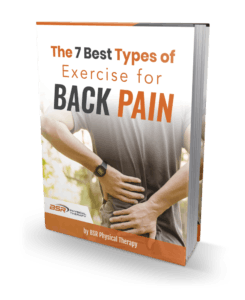Is avoiding strength training with weights best for your back pain? Many people believe they should not lift weights because of their aching back. This belief is unhelpful and can perpetuate your back pain. Strength training is a safe and effective way to decrease persistent back pain. This article teaches you how to structure your strength training program and get the best results.
Strength Training Proven to Decrease Back Pain
Multiple studies prove the benefits of strength training for people with persistent back pain. A 2014 study at the University of Florida separated 49 people with back pain into 3 groups. One group performed low-back muscle exercises. The second group performed a total body strength training program. The third group performed no exercise. After 4 months both exercise groups showed large improvements in back pain. Disability in the total-body strength training group decreased the most.

Another study out of Sweden showed similar benefits. In this study, lumbar stabilization exercises were compared to heavy strength training. The heavy strength training program consisted of only the deadlift exercise. Pain, disability, and quality of life showed significant improvements in both groups. These studies prove strength training with weights is at least as effective as traditional low back-specific exercises.
The 5 Basic Movement Patterns to Manage Back Pain
Designing your strength training program doesn’t have to be complicated. The best programs incorporate all major muscle groups of the body. More importantly, the 5 basic patterns of movement are included. These are the squat, hinge, push, pull, and carry. We will discuss each as they relate to low back pain in greater detail.
For recommendations about sets, reps, frequency, and the amount of weight to use go here (Preventing Muscle Loss).
1. Squat
The squat wrongfully gets a bad rap. Squatting is not harmful to your lower back. Squatting is a fundamental movement pattern that you repeatedly perform every day. There are many squat exercise variations to choose from. The leg press is a basic squat pattern performed with a machine. This is a nice option for people with back pain because the spine is supported. The barbell back squat is a more technically challenging exercise. There are many variations in between.
A goblet squat is an excellent option because it helps reinforce proper squatting mechanics. The basics of the squat include keeping the chest up, back straight, and knees out. You also want to “sit back” into the squat as if you were sitting in a chair. When performed properly, the squat is arguably the best total body exercise.
2. Hinge
The hinge pattern involves flexing your hips and keeping a neutral spine. The deadlift and all its variations are the classic hinge exercises. These exercises strengthen your backside. This includes your hamstrings, glutes, and low back muscles.
Unfortunately, many people don’t properly hinge. Improper form combined with heavy loads often leads to injury. Get help from your physical therapist if you are having difficulty. The Romanian deadlift (RDL) is mastered before progressing to a conventional deadlift.
3. Push
Push exercises include the bench press and military press. The push-up and all its variations are also excellent options. These exercises strengthen your shoulders, chest, and arms.
To get the best total body benefit, we recommend the landmine press. The landmine press is performed in a standing position. This activates your lower body, core, and upper body muscles. It is also less stressful on your shoulder joints.
4. Pull
Pull exercises include the row, pull-up, and lat pull-down. These exercises strengthen your upper back, shoulders, and arms. Similar to pressing movements, we recommend standing or weight-bearing exercises with free weights instead of seated machine-based exercises. This activates your lower body, core, and upper body muscles more functionally.
Rows can be performed in many different fashions. Be sure to include at least 1 row exercise in your program.
5. Carry
Loaded carries are often neglected in strength training programs. However, carrying heavy objects is a natural part of our lives. Your body should be prepared for this; especially if you have a history of back pain. There is no better core exercise than the loaded carry.
When starting, incorporate the 2-arm farmers carry with kettlebells or dumbbells. Begin with 20% of your body weight in each hand. Over time, perform the farmer’s carry with at least 50% of your body weight in each hand.
The length of your carry should be at least 25 feet and back. With heavier loads, walk shorter distances. And if using lighter loads, walk a little further.
Get Help with Total Body Strength Training for Your Back Pain
If you have been dealing with back pain for many months or even years, strength training will help. It is important to start small. Choose 1 exercise from each of the 5 fundamental movement patterns described here. Start with 5 exercises performed 2 to 3 days per week. Keep the weights light until you master the movement pattern and gain confidence.
If you need help, call your physical therapist. We are here to help you move and exercise without pain.


